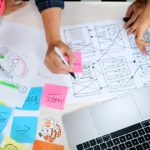Throughout the years, products and services have been there for us to use conveniently. From phones, accessories, to processes in transactions, all of them have given us the needs that we would want to experience. Yet, these products and services are not invented overnight; they are carefully designed and tested for them to work and efficiently as much as possible.
What is a design process?
A design process is a systematic series of steps wherein it goes through plans, and defines how the product works before it is built. This process gives a way for inventors and designers to create the best possible product for their consumers. Everything is well researched based on the preferences of the target market, while also giving them something more beyond what they can possibly imagine. Aside from this, a good design process lets developers create enhancements as they go through a procedure of effective measures to make something greater out of their inventions.
Hence, it breaks down a large concept into manageable chunks, where different fields are also highly regarded for product effectiveness and its success.
Why is the design process important?
Behind every successful product lies the thorough research and expertise of professionals. Creating a ready-made product gives little to no value to your target market, in a way that solutions are just momentary which does not increase the value in the client’s eyes. To be able to hit the bulls-eye, designers take ample time and give their best efforts to create a design that is custom-made and distinctive compared to typical competitors.
With the extensive design process, product designers pool their knowledge, skills, and evaluate what they can offer to clients; all of these aspects work hand-in-hand to create a meaningful finished product for the consumers in the long run.
Therefore, the design process is undeniably the sole framework for better product invention based on comprehensive research and tests which can make the final product unique to be used easily by everyone.
Advantages of Design Process
Expectations are met
While planning for a design, there is actually a goal for every inventor; from the physical attributes to its specs (as for products), every detail is met with the underlying problems they want a resolution to. In doing a design process, expectations are set on the table so designers would eventually come up with a single product that can address expectations. Thus, these concerns are met, where the clients would feel at ease once they avail of the product.
Mitigates Failures
Due to the thorough understanding of the problems, the design process decreases the risk of failures through tests and optimization. Remember that designs are not made in just a single snap -time, effort, and considerable studies are made so there will be no disappointment where it can cater to a lot of clients with its infinite possibilities.
Improves Outcomes
The design process makes a way of creating outcomes that can satisfy clients, in a way that all, or in any case most of their problems are sought, filtered, and carried out with solutions that are undeniably convenient for them. Therefore, it will improve outcomes for the business as they can also design something friendly for everybody.
When a certain product is launched, most of us buy them because of its look or specs. However, before it is marketed to audiences, every product is deliberately designed to target our individual preferences. Considerably, they go through a diligent process and work on with time and various resources so they can be delivered and used without a hassle. Thus, the design process is the key component in creating a product that is unique and can go beyond its competition.





